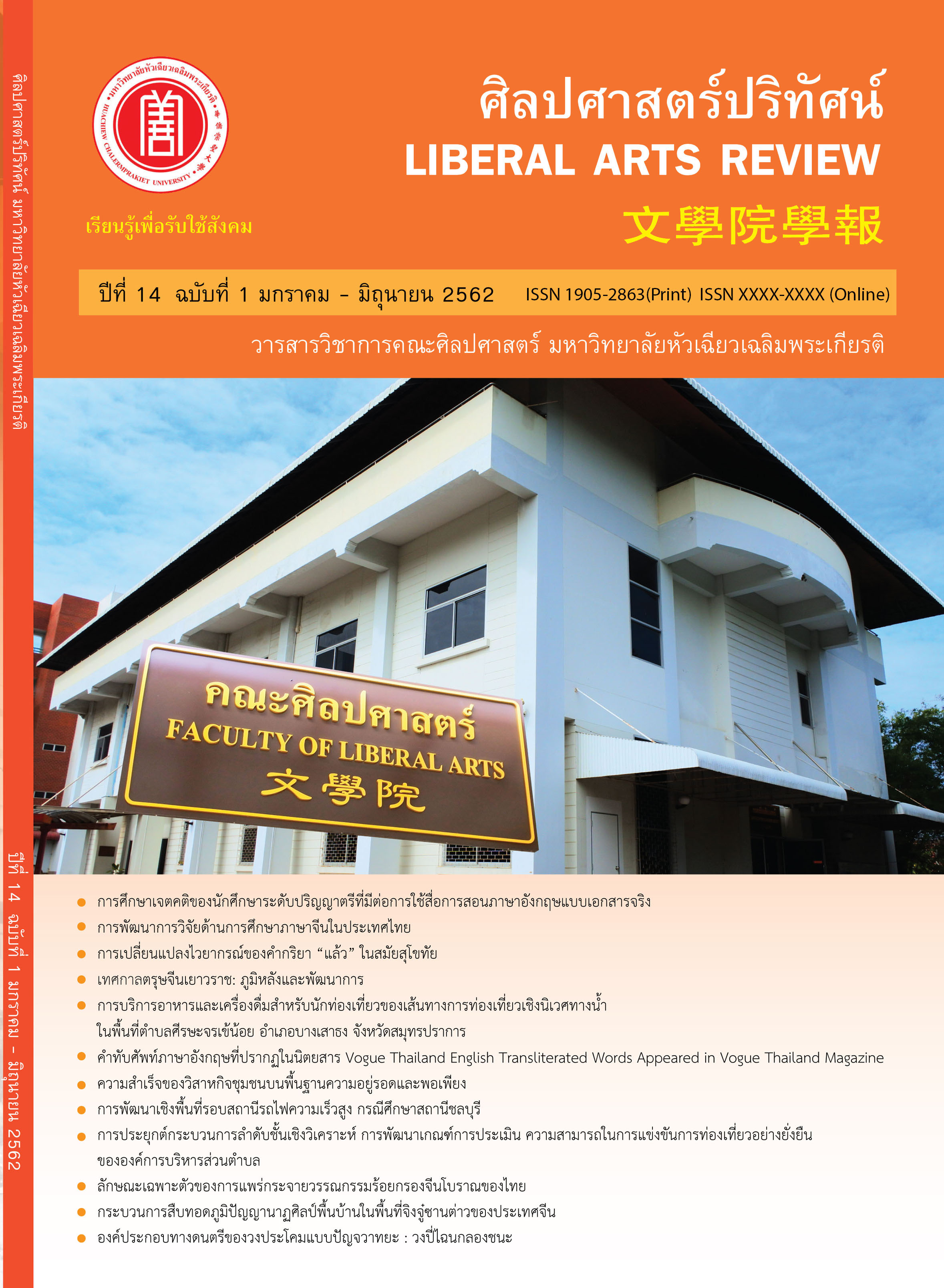A Study of Undergraduate Students’ Attitudes toward English Authentic Teaching Materials
Keywords:
English authentic teaching materials, attitudeAbstract
This study aims at investigating undergraduate students’ attitudes toward authentic teaching materials exploited in English classes. The sample group consisted of 230 English-major undergraduate students of the Faculty of Liberal Arts, Huachiew Chalermprakiet University who enrolled in English courses in which instructors used authentic teaching materials for their classes in the academic year 2016. Questionnaires were applied as research instruments. In order to investigate the students’ attitudes toward English authentic teaching materials, the term “attitude” was categorized into three aspects; cognitive, affective and behavioral attitude.
After analyzing the results, it was found that in general the students had positive attitudes toward English authentic teaching materials with the average attitude score of 3.88. Most students agreed that authentic teaching materials are beneficial for their lives and future careers with the highest average attitude score out of the 18 items in the questionnaires. Also the students stated that authentic materials can improve their English reading skills, and increase the knowledge and understanding of native speakers’ cultures. However, a number of students expressed low average attitude toward English authentic teaching materials in the points that such materials contain complicated grammatical structures and difficult vocabulary. Possible factors underlying these results were discussed and recommendations for the highest effectiveness of English language teaching were provided.
References
Ahellal, M. (1990). Using authentic materials in the classroom: theoretical assumptions and practical considerations. English Teaching Forum, 28(2), 37-39.
Al-Azri, R. H., & Al-Rashdi, M. H. (2014). The effect of using authentic materials in teaching. International Journal of Scientific and Technology Research, 3(10), 249-254.
Retrieved from https://pdfs.semanticscholar.org/a8da/ed79131bf72bd4e51d1e 21212426e73113b7.pdf
Al-Musallam, E. I. (2009). College instructors’ and learners’ attitudes to authentic EFL reading materials in Saudi Arabia. (Master’s thesis). Retrieved from https://www.awej.org/images/Theseanddissertation/EnasAlMusallam/enasfullthesis.pdf
Berardo, S. (2006). The use of authentic materials in the teaching of reading. The Reading Matrix, 6(2), 60-69.
Chambers, G. N. (1999). Motivating language learners. Clevedon : Multilingual Matters Ltd.
Guariento, W., & Morley, J. (2001). Text and task authenticity in EFL classroom. ELT Journal, 55(4), 347 – 353.
Kılıç, Z. V., & Ilter, B. G. (2015). The effect of authentic materials on 12th grade students’ attitudes in EFL Classes. International Association of Research in Foreign Language Education and Applied Linguistics ELT Research Journal, 4(1), 2-15. Retrieved from https://dergipark.ulakbim.gov.tr/eltrj/article/view/5000141266/pdf_11
Kilickaya, F. (2004). Authentic materials and culture content in EFL classrooms. The Internet ELT Journal, 10(7). Retrieved from https://iteslj.org/Techniques/ Kilickaya-AutenticMaterial.html
Kim, D. (2000). A qualitative approach to the authenticity in the foreign language classroom: A study of university students learning English in Korea. Texas Papers in Foreign Language Education, 5(1), 189-205.
Krashen, S. D., & Terrell. T. D. (1983). The natural approach: Language acquisition in the classroom. Hayward, Calif: Alemany Press.
Krashen, S. D. (1985). The input hypothesis: Issues and implications. London: Longman.
Miller, M. K. (2005). Improving aural comprehension skills in EFL, using authentic materials: An experiment with university students in Nigata, Japan. (Unpublished Master’s Thesis). University of Surrey, Australia.
Pairin, S. (2011). Using authentic texts to develop reading ability of mattayomsuksa 5 students at Princess Chulabhorn’s College Chonburi. (Master’s Thesis), Srinakharinwirot University, Bangkok.
Pinsonneault, B. C. (2008). Authentic input in early second language learning. (Master’s Thesis). University of Massachusetts Amherst, Massachusetts, United States.
Retrieved from https://scholarworks.umass.edu/cgi/viewcontent.cgi?article =1236&context=theses&sei-redir=1&referer=
Plungsangmas, S. (2006). Using authentic materials to enhance mattayom suksa II students’ reading comprehension ability. (Master’s Thesis), Srinakharinwirot University, Bangkok.
Saleh, S. E. (2017). Some Libyan EFL university students’ attitudes towards using authentic materials for reading classes. Theory and Practice of Second Language Acquisition, 3(1), 61–75. Retrieved from www.journals.us.edu.pl/index.php/ TAPSLA/article/download/5033/4248
Shu-Chin, S. (2008). Attitude of students and instructors toward authentic materials in selected adult TESL programs. Retrieved from https://citeseerx.ist.psu.edu/viewdoc/ download?doi=10.1.1.539.8035&rep=rep1&type=pdf
Spelleri, M. (2002). From lessons to life: Authentic materials bridge the gap. ESL Magazine 5(2), 16–18.
Swaffar, J. K. (1985). Reading authentic texts in a foreign language: A cognitive model. The Modern Language Journal, 69(1), 15-34.
Tanasavate, K., & Chinwonno, A. (2013). A study of Thai EFL learners' and teachers' Use of authentic materials. An Online Journal of Education, 8(2), 178-190. Retrieved from https://portal.edu.chula.ac.th/pub/tefl/images/ phocadownload/OJED2014/Kuliga%20Tanasavate_2556.pdf
Thomas, C. (2014). Meeting EFL learners halfway by using locally relevant authentic materials. English Teaching Forum 2014, 52(3), 14-23.
Yamane, T. (1973). Statistics: An introductory analysis (3rd ed.). New York: Harper and Row.
Downloads
Published
How to Cite
Issue
Section
License
บทความที่ได้รับการตีพิมพ์เป็นลิขสิทธิ์ของวารสารศิลปศาสตร์วิชาการและวิจัย
ข้อความที่ปรากฏในบทความแต่ละเรื่องในวารสารวิชาการเล่มนี้เป็นความคิดเห็นส่วนตัวของผู้เขียนแต่ละท่านไม่เกี่ยวข้องกับมหาวิทยาลัยหัวเฉียวเฉลิมพระเกียรติ และคณาจารย์ท่านอื่นๆ ในมหาวิทยาลัยฯ แต่อย่างใด ความรับผิดชอบองค์ประกอบทั้งหมดของบทความแต่ละเรื่องเป็นของผู้เขียนแต่ละท่าน หากมีความผิดพลาดใดๆ ผู้เขียนแต่ละท่านจะรับผิดชอบบทความของตนเองแต่ผู้เดียว




